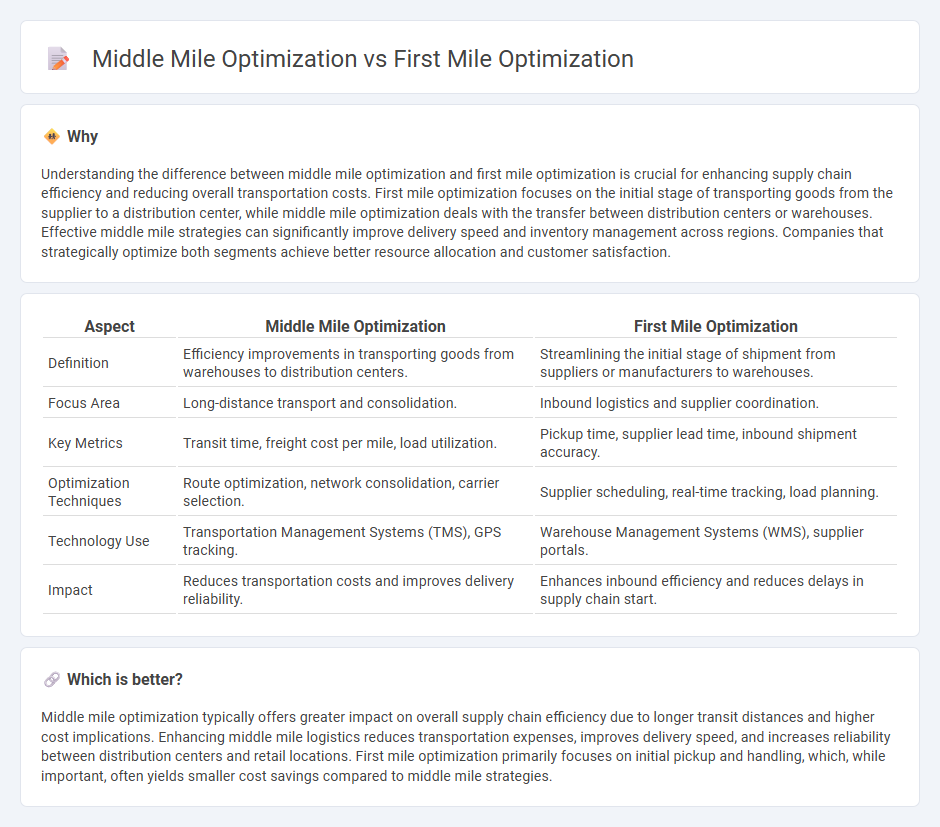
Middle mile optimization focuses on streamlining the transportation of goods between warehouses and distribution centers, reducing transit times and lowering costs through advanced route planning and load consolidation. First mile optimization enhances the initial stage of logistics by improving pickup efficiency, inventory accuracy, and timely order processing from suppliers or manufacturers. Explore the key strategies and technologies driving efficiency in both middle mile and first mile logistics operations.
Why it is important
Understanding the difference between middle mile optimization and first mile optimization is crucial for enhancing supply chain efficiency and reducing overall transportation costs. First mile optimization focuses on the initial stage of transporting goods from the supplier to a distribution center, while middle mile optimization deals with the transfer between distribution centers or warehouses. Effective middle mile strategies can significantly improve delivery speed and inventory management across regions. Companies that strategically optimize both segments achieve better resource allocation and customer satisfaction.
Comparison Table
| Aspect | Middle Mile Optimization | First Mile Optimization |
|---|---|---|
| Definition | Efficiency improvements in transporting goods from warehouses to distribution centers. | Streamlining the initial stage of shipment from suppliers or manufacturers to warehouses. |
| Focus Area | Long-distance transport and consolidation. | Inbound logistics and supplier coordination. |
| Key Metrics | Transit time, freight cost per mile, load utilization. | Pickup time, supplier lead time, inbound shipment accuracy. |
| Optimization Techniques | Route optimization, network consolidation, carrier selection. | Supplier scheduling, real-time tracking, load planning. |
| Technology Use | Transportation Management Systems (TMS), GPS tracking. | Warehouse Management Systems (WMS), supplier portals. |
| Impact | Reduces transportation costs and improves delivery reliability. | Enhances inbound efficiency and reduces delays in supply chain start. |
Which is better?
Middle mile optimization typically offers greater impact on overall supply chain efficiency due to longer transit distances and higher cost implications. Enhancing middle mile logistics reduces transportation expenses, improves delivery speed, and increases reliability between distribution centers and retail locations. First mile optimization primarily focuses on initial pickup and handling, which, while important, often yields smaller cost savings compared to middle mile strategies.
Connection
Middle mile optimization enhances the efficiency of transporting goods between warehouses and distribution centers, directly impacting first mile operations by ensuring timely and accurate pickup from suppliers. Effective first mile optimization relies on seamless coordination with middle mile logistics to reduce delays, lower transportation costs, and improve overall supply chain visibility. Together, these stages form an integrated network that supports faster delivery times and optimized inventory management.
Key Terms
**First Mile Optimization:**
First Mile Optimization focuses on enhancing the initial stages of the supply chain where raw materials or products are picked up from suppliers or manufacturers, aiming to reduce transit times, minimize handling costs, and improve shipment accuracy. This phase involves strategic route planning, efficient loading processes, and leveraging advanced tracking technologies to ensure seamless handoffs to carriers. Explore our detailed insights to understand how First Mile Optimization can significantly elevate your supply chain efficiency.
Supplier Coordination
First mile optimization focuses on improving supplier coordination by streamlining order processing, enhancing communication, and ensuring timely material readiness. Middle mile optimization concentrates on efficient transportation management between warehouses and distribution centers to reduce transit time and costs. Explore in-depth strategies to maximize supplier collaboration and transportation efficiency for better supply chain performance.
Inventory Management
First mile optimization in inventory management emphasizes efficient procurement, accurate demand forecasting, and timely supplier coordination to ensure raw materials or products enter the supply chain smoothly. Middle mile optimization focuses on warehousing strategies, inventory accuracy, and transportation planning to facilitate seamless movement of goods between distribution centers. Explore deeper insights into how these inventory management stages enhance operational efficiency and reduce costs.
Source and External Links
What is first-mile delivery? How to optimize first-mile logistics - First-mile optimization involves automating processes to increase efficiency in transporting goods from warehouses to distribution hubs, including better truck loading, workforce task reassignment, and data-driven insights to reduce costs and improve delivery times.
Supply Chain Excellence: Optimizing the First Mile - Optimization uses digital tools such as route and shipment planning software and automation to reduce errors, improve inventory tracking, consolidate shipments, and plan the most efficient transport routes based on real-time data.
What is first mile delivery & how to optimize it? - Key strategies include proper packaging and labeling to avoid damage, digital transformation, real-time monitoring, enhanced communication, and balanced focus on both first-mile and last-mile operations to ensure overall supply chain success.
 dowidth.com
dowidth.com